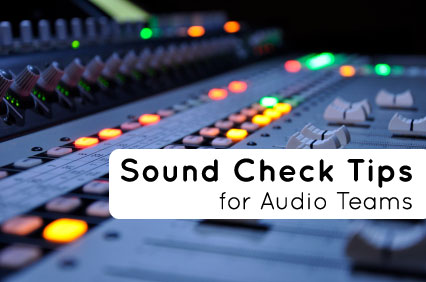Improve Your Sound Check: For the Audio Team

Sound check is one of the most critical steps in delivering an excellent weekend service. It ensures that all the complicated patching, routing, conversion, and reproduction are happening the way you want them to happen. When sound checks go bad (coming soon to your local Fox station!), it can put off the mood of both the worship band, the worship leader, and the production team. It is an easy way for the evil one to interrupt and distract you from the reason you are at church. By taking the time to prepare for your entire service, you reduce the chance for failure, distraction, and frustration.
To The Audio Team
Sound check is NOT the time to find out if your lines work, or if that sketchy DI is going to hold up another week. Before the worship team even sets foot on the property, you should have already made use of a tone generator (like this). If you can’t find $21 in your budget for one, ask your team to sacrifice their Starbucks for a weekend and buy one. The following items, at a minimum should be checked every single time:
- For guitars, plug an instrument cable into that direct box and use the tone generator into the instrument cable. Checking this tests your 1/4, your DI, your XLR, etc.
- For keyboards, turn it on and play it! It doesn’t need to be pretty to know if it works. If you don’t have the keyboard there for whatever reason, test with the instrument cable, just like the guitars.
- For instrument mics: snapping in front of them works great. Never tap or blow on them.
- For vocal mics: Stand in the position that the vocalist will stand and hold it properly. You are more likely to identify sources of feedback or other problems if you mimic the actual use as closely as possible.
- For headworn mics: PUT THEM ON AND TEST THEM. These mics tend to have cables that fail frequently and see a lot of rough handling. By putting it on, you’ll not only check that the mic is passing signal but that the ear piece or head-basket hasn’t been damaged. It also checks that the wireless receivers are working properly.
- Check any videos/tracks/CD’s that you’ll be using and ensure they are working properly.
While that might seem like a lot, it should only take ~20 minutes for a typical setup once you get used to it. The important part is that you check EVERYTHING, EVERY TIME. While all of that is happening, you also need to be ensuring that the test tone, or test voice, is being heard in wedges and the in-ear system. Depending on your setup, this can be a complicated system and needs to be part of your pre-band routine.
As the worship team and vocalists enter, remember a few key things:
- They may not know your setup. Help them locate their position on stage, their microphones, in-ears, etc. If you have new members, make sure they understand how to ask for changes and how to work your in-ear system if you have one. The audio team serves the worship team in this capacity and being proactive will help things go well.
- Have a few common things handy. People make mistakes; they forget patch cables, in-ears, batteries, etc. Having these nearby the stage ensures that a simple mistake doesn’t derail your service while someone has to go dig a battery out of a case somewhere.
- Communicate to everyone the best way to ask for changes. Do you have a stage manager that everyone should talk to? Should they shout to the booth? Have they been through the school of audio hand-signals? Establishing a prescribed channel for communication helps them feel cared for and allows them to not worry about potential problems.
- Politely remind the worship team to not play during sound-check so you can tweak and tune each instrument as quickly and effectively as possible.
- Establish a pattern and stick to it. I personally prefer to do drums -> bass -> electrics -> keys -> acoustics -> vocals. However you do it doesn’t matter, but sticking to a pattern helps the worship team know what to expect and how much time is remaining.
- For each instrument, check your gain, EQ, compression, and effects. Spend enough time to get the sound 90% of the way there. Save the last 10% for adjustments within the mix. You’ll probably change just about everything you set here anyway, so taking an inordinate amount of time here serves no one well. When you finish an instrument/player, check in with the musician and make sure they can hear themselves adequately and are satisfied with the sound.
- Once each player is checked, ask the team to play through a single song so they (or you) can rough in wedge/in-ear mixes so they can begin rehearsal. After that first song, check in and ask if anyone needs changes. If not, you’ll all done – nice job. Now the band is off and running for rehearsal.
Sound-check shouldn’t be hard once everyone figures out why they do it and how much better a rehearsal can go once it is done. If you and your team do it different, I’d love to hear what you do and why! Everyone has a different setup, different cultures, and different solutions. This isn’t the end-all-be-all sound-check guide, but if you’re struggling with technical problems and inconsistency, it’s a solid place to start.



